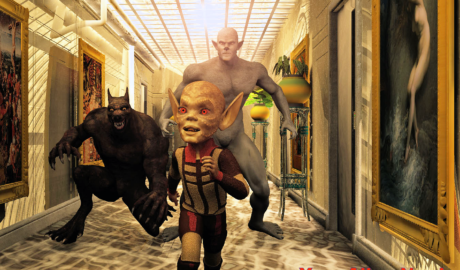THE EMPIRE CAN WAIT – CHAPTER 6, PART 1
Fillet of a fenny snake,In the cauldron boil and bake.Eye of newt and toe of frog,Wool of bat and tongue of dog,Adder’s fork and blind-worm’s sting,Lezard’s leg and owlet’s wing,For a charm of powerful trouble,Like a hell-broth boil and bubble. (William Shakespeare, Macbeth, Act IV, Scene I) Starmont, coordinates 91.349/-74.222/000.001JulyContinue Reading
THE EMPIRE CAN WAIT – CHAPTER 5, PART 2
“Hey, Cthulhu!” Uful’lan shouted, suddenly popping out from cover. For a moment, the creature paused its repeated battering of an overturned table, behind which a pair of Cardassians were huddled in terror. As Cthulhu’s attention shifted to the k’rell, its nerve endings flared with a series of crackling purple sparks.Continue Reading
THE EMPIRE CAN WAIT – CHAPTER 5, PART 1
Twiglet ran at breakneck speed, not daring to look back—but she wasn’t under any illusions. Any second now, she expected to feel the werewolves’ fetid breath on her neck… and then she’d die. Funny, she thought grimly. One hundred and thirty-seven years old, and it would all end here… inContinue Reading
Majestic-12: Fact, Hoax, or Disinformation?
Few names in UFO history carry as much mystique as Majestic-12 (or MJ-12). Allegedly formed by President Truman in 1947 after the Roswell incident, this supposed secret committee of scientists, military officers, and intelligence officials is said to have managed the recovery and study of crashed alien craft and theirContinue Reading
THE EMPIRE CAN WAIT – CHAPTER 4, PART 2
“INSERT YOUR TICKET, PLEASE,” the door said.Kyle swiped the plastic pass.“THANK YOU, SIR, AND… ENJOY!” the metallic voice chimed. The interior was retro-styled, centered around a large stage at the back, and dotted with small round tables. The first floor of the Nine Wonders was dedicated to female attractions, andContinue Reading
Alien Cats and the Fermi Paradox: Are They Just Not Into Us?
The Fermi Paradox has long haunted astronomers, philosophers, and science fiction writers alike: if the Universe is so vast and filled with billions of potentially habitable worlds, where are all the aliens? We send out radio waves, beam golden records into the void, and scan the skies with powerful telescopes—yetContinue Reading
THE EMPIRE CAN WAIT – CHAPTER 4, PART 1
“Here it is, the new district that the whole world envies us.Soho, Pigalle, Saint Pauli, Forty-second Street? Much more than that!The President wanted to build a nice,bustling neighborhood for his subjects: Caligula Two. […]The Japanese sin districts, especially the Kabuki-cho in Tokyo, are inspired by it.They always copied from us,Continue Reading
Galactic Voids: Cosmic Dead Zones or Cloaked Civilizations?
Imagine staring into the vast night sky and seeing not just twinkling stars and shimmering galaxies—but vast stretches of nothing. No light, no galaxies, no stars, just darkness. These are galactic voids—some of the most significant structures in the universe, paradoxically defined by their emptiness. But what if these enormousContinue Reading










